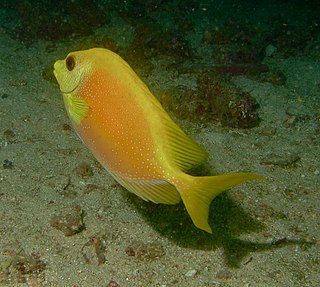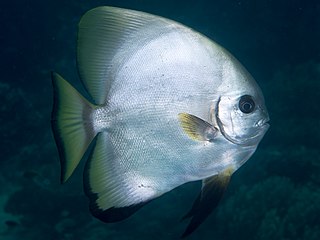
The orbicular batfish, also known as the cooper batfish, circular batfish, orbiculate batfish, round batfish, narrow-banded batfish or orbic batfish is a species of marine ray-finned fish belonging to the family Ephippidae, the spadefishes and batfishes. This species is found in the Indo-Pacific but has been recorded outside its native range in the western Atlantic Ocean.

Ephippidae is a family of percomorph fishes, the spadefishes, in the order Moroniformes. These fishes are found in the tropical and temperate oceans of the world, except for the central Pacific.

Acanthurus triostegus, the convict surgeonfish, convict surgeon, convict tang or fiveband surgeonfish, is a species of marine ray-finned fish belonging to the family Acanthuridae which includes the surgeonfishes, unicornfishes and tangs. This species has a wide Indo-Pacific distribution.

Zebrasoma scopas, the brown tang, twotone tang, scopas tang or brush-tail tang, is a species of marine ray-finned fish belonging to the family Acanthuridae which includes the surgeonfishes, unicornfishes and tangs. The brown tang is found throughout Oceania and is a herbivorous fish, feeding predominantly on filamentous algae. It is a highly popular fish in the aquarium trade.

The sailfin tang, the Pacific sailfin tang, purple sailfinned tang or sailfin surgeonfish, is a marine ray-finned fish belonging to the family Acanthuridae which includes the surgeonfishes, unicornfishes and tangs. This fish is found in the Pacific Ocean and is popular in the aquarium hobby.

Platax pinnatus, also known as the longfin batfish, pinnate spadefish, pinnate batfish, pinnatus batfish, dusky batfish, shaded batfish, or red-faced batfish is a species of marine ray-finned fish belonging to the family Ephippidae, the spadefishes and batfishes. This species is found in the western Pacific Ocean and occasionally is kept in marine aquariums.

Pomacanthus semicirculatus, also known as the semicircled angelfish, Koran angelfish, blue angelfish, zebra angelfish or half-circled angelfish, is a species of ray-finned fish, a marine angelfish, in the family Pomacanthidae. It is found in the Indo-West Pacific Ocean. It occasionally makes its way into the aquarium trade.

Platax teira, also known as the teira batfish, longfin batfish, longfin spadefish, or round faced batfish is a species of marine ray-finned fish belonging to the family Ephippidae, the spadefishes and batfishes. This species is found in the Indo-West Pacific.

Acanthurus pyroferus, chocolate surgeonfish, mimic surgeonfish, orange-gilled surgeonfish, Pacific mimic surgeon, and yellowspot surgeon, is a species of marine ray-finned fish belonging to the family Acanthuridae, which includes the sugeonfishes, unicornfishes and tangs. This species is found in the Indo-Pacific region.

Acanthurus lineatus, the lined surgeonfish, blue banded surgeonfish, blue-lined surgeonfish, clown surgeonfish, pyjama tang, striped surgeonfish, and zebra surgeonfish, is a species of marine ray-finned fish belonging to the family Acanthuridae, the surgeonfishes, unicornfishes and tangs. This species is found in the Indo-Pacific region.

Acanthurus maculiceps, the white-freckled surgeonfish, yellow-freckled surgeonfish, pale-lined surgeonfish,spotted-faced surgeonfish or earbar surgeonfish, is a species of marine ray-finned fish belonging to the family Acanthuridae, the surgeonfishes, unicornfishes and tangs. This species is found in the Indo-West Pacific region.

Hoplolatilus starcki, Stark's tilefish, purple-headed sand tilefish or bluehead tilefish, is a species of marine ray-finned fish, a tilefish belonging to the family Malacanthidae. This species is native to the central Indo-Pacific.

Acanthurus auranticavus, the ringtail surgeonfish or orange-socket surgeonfish, is a species of marine ray-finned fish belonging to the family Acanthuridae, the surgeonfishes, unicornfishes and tangs. This species is found in the Indo-West Pacific.

Acanthurus thompsoni, the night surgeonfish, chocolate surgeonfish, Thompson's surgeonfish, Thompson's tang or whitetail surgeonfish, is a species of marine ray-finned fish belonging to the family Acanthuridae which includes the surgeonfishes, unicornfishes and tangs. This species has a wide Indo-Pacific distribution.

Naso caesius, the grey unicornfish or silverblotched unicornfish, is a species of marine ray-finned fish belonging to the family Acanthuridae, the surgeonfishes, unicornfishes and tangs. This species occurs in the Indo-Pacific region.

Naso fageni, the horseface unicornfish or blunt unicornfish, is a species of marine ray-finned fish belonging to the family Acanthuridae, the surgeonfishes, unicornfishes and tangs. This fish is found in the Indo-Pacific region.

Naso tonganus, the bulbnose unicornfish, hump-nosed unicornfish, humphead unicornfish, or the humpnose unicorn, is a species of marine ray-finned fish belonging to the family Acanthuridae, the surgeonfishes, unicornfishes and tangs. This species is found in the Indo-Pacific. It is of value in commercial fisheries.

The blue-spotted spinefoot, the coral rabbitfish, coral spinefoot, ocellated spinefoot or orange spinefoot is a species of marine ray-finned fish, a rabbitfish belonging to the family Siganidae. It is found in the Indo-Pacific where it is often caught as a food fish and occasionally as an aquarium fish.

Proteracanthus is a monospecific genus of marine ray-finned fish belonging to the family Ephippidae, the spadefishes and batfishes. The only species in the genus is Proeracanthus sarissophorus which occurs in coral reefs around Malaysia, Borneo, and Sumatra. This species is also known as the harpoon spadefish, or in Malaysia as drummer, knightfish, rudderfish or sea chub. This species grows to a length of 32.5 centimetres (12.8 in) SL.

Platax boersii, the golden spadefish or Boers’ batfish, is a species of marine ray-finned fish belonging to the family Ephippidae, the spadefishes and bay fishes. This species is found in the Indo-West Pacific.




















